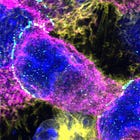The title is a reference with my favorite cards in Magic The Gathering, The Eldrazi.
I spent weeks kinda sick, and nothing good was published for the most part, I got back into it, and researchers decided to publish all the great papers, all at once… lol. So today is a somewhat self-serving but also a very necessary article by the simple fact that I like having a normal functional brain. I try at least.
Patients recovering from COVID-19 who presented with anosmia during their acute episode have behavioral, functional, and structural brain alterations
Anosmia, the fancy scientific and medical word for “Losing the sense of smell” has been present since a few months after the first wave of SARS-CoV-2, back in 2020. It took a few years but the mechanism was uncovered, the virus infected specific olfactory cells, infiltrated (went deeper into) the area, and causes damage. Damage and regeneration can take time, and there is significant nutrient variation between each person, thus some experience persistent loss of smell and distorted taste, while others bounce back fast. Other potential mechanisms exist too.
What we didn’t know so far was if anosmia was correlated with any form of long-term changes to the brain, or behavioral changes (also a sign of structural and functional alteration of the brain). Especially if “mild” and severe Covid have differences.
By using a multifaceted approach the authors correlated loss of smell, loss of taste during different phases of the infection, mild to moderate, and acute symptoms and observing behavioral changes, rather than measuring structural changes. Cognitive deficits often emerge (in this study) in a subset of the population that is more vulnerable, in line with other research, such as individuals with specific mental, and psychiatric disorders and older people.
Patients with anosmia exhibited more impulsive decision-making changes during tests characterized by high uncertainty and volatility. Hospitalized patients demonstrated a perseverative decision-making change, reflecting decreased strategic flexibility. The behavioral changes, when accompanied by anosmia were associated with BOLD (Blood-Oxygen-Level-Dependent) signal, an imaging test to analyze brain blood flow, and this flow was decreased in the decision-making areas of the brain such as lateral prefrontal cortex, media frontal cortex, and left temporoparietal regions.
In terms of structural brain changes, they found that patients with a history of olfactory dysfunction, rather than hospitalization, exhibited the most significant alterations. Specifically, cortical thickness analysis revealed thinning in parietal areas among patients with anosmia, suggesting structural changes in these regions. This is to say, even without hospitalization, anosmia can be a marker for brain alterations, affecting behavior, among other metrics, such as long-term neurocognitive conditions (anosmia is often observed years before diseases such as Alzheimer’s show their initial symptoms).
Thus leading us to the reason I decided to write this article, and for the title. This paper was kindly provided by Dee one of my followers on Twitter and readers here =).
Evolution of SARS-CoV-2 in the murine central nervous system drives viral diversification
After Omicron surfaced in the world a perceptible change in disease severity was observed, it suddenly shifted from people having severe pneumonia and aggressive systemic symptoms to “mild disease”. But if you looked at broader and especially unconnected data points, from an interdisciplinary perspective, that history didn’t feel quite right. This was my position as early as 2022, but repeated in 2023.
We come back to what I came to term “receptor hierarchy”, the patchwork of different proteins that are SARS-COV-2 Spike Protein, and its predilection for using a dozen other receptors if ACE2 is not available. Thankfully the virus didn’t drop the synthetic FCS, it mutated around it, but you can see as early as Feb 2021 I was already aware and afraid of any changes in this Superantigenic site-HIV Mimic-Endotoxin binding sequence.
SARS-CoV-2 neuroinvasion selects for FCS mutations
To understand the pressure of immunity in viral evolution, the authors sequenced the whole genome of the lungs and brains of mice infected with SARS-CoV-2. Vaccinated mice experienced a reduced viral diversity in the lungs, meaning the virus had less opportunity to adapt, but in contrast to the lungs, when the virus enters the brain it continues to undergo mutations and significant changes. In the brain the FCS undergoes mutations and changes how the virus behaves in the CNS, thus adapting to its environment.
How does SARS-CoV-2 enter cells in the CNS, when the nervous system has lower expression of ACE2 and TMPRSS2 compared to the lung ? ACE2 is found in neurons, vascular, and endothelial cells within the brain, which also has high levels of Cathepsin B and L (both important soon). By testing how different strains of the virus behave in different cells, the authors found that mutated FCS prefer to use cathepsin B/L over TMPRSS-2, thus changing how it enters cells in different organs.
Cathepsin B can aid and help the virus infect the brain for a longer period and it participates in the accumulation of Spike Protein, and viral fragments in the brain and nervous system, something I experienced to the fullest in my last infection. Cathepsin L is one of the open secrets of the virus, it is both an HIV mimic and a hidden FCS method.
Viruses with mutated Spike protein (ΔFCS) are attenuated in the lungs, having significant trouble replicating in the organ even after a few days post-exposure, but still, the virus had trouble infecting the CNS directly and there is high variation in the brain even after days of infection, but ΔFCS had slightly higher viral RNA and infectious virus in the CNS. This of course makes me remind you of a 2023 article, a little over a year ago.
Via direct infection in the brain (bypassing many protective immune steps) the authors also observed that the virus is not only capable of infecting and replicating in the brain via a unique mechanism after mutating the FCS, but it can “traffick” back to the lungs, meaning once in the brain, it can undergo many mutations and get back into the lungs. Depending on the organ and cells the virus infects first (lung or brain), the virus will go through different mutational pressures, and change its FCS, especially when it goes from the brain back to the lungs.
Since the CNS and the brain are both considered immune-privileged sites, where the immune response can’t be aggressive, this can enable the virus to create longer-term infection, induce systemic inflammation, and systemic metabolic change and both create a “variant factory”. It has been my argument for a couple of years now that the virus is persisting in the CNS, somehow.
We now have evidence that can be backed by real-world (distinct) data points and an interdisciplinary approach that change in the infamous Furin Cleavage Site did indeed attenuate the virus in the lungs, with the trade-off of recovering the neurotropism of other coronaviruses. A problem because the virus has many distinct parts and effects that directly affect neurological health.
Leaving us with this.
I mean, who could have possibly forecast such outcomes ? I will repeat myself, Omicron is a stealth-class bioweapon. I have lost count of how many rashes people have told me they had for weeks after recent Omicron infections. It is not like this protein-mediated neurodegeneration. Causing intestinal barrier dysfunction.
In the last 6 weeks, I have gotten quite a few DMs and e-mails of people who got infected with “Mild Omicron bro”, and couldn’t clear the infection for weeks. Months later, some of their White Blood Cells, especially lymphocytes got killed en mass. And nobody won’t connect the dots, because who would think a mild Omicron infection 4-6 months ago has anything to do with whatever problem someone has at that point ?
If you take a minimal approach to taking care of your health, it shouldn’t be a problem though =). You can avoid many of the effects referenced in this article in regards to neurological health, especially long-term, by just adding Choline as a supplement. I would personally add Taurine daily, or when infected at least (grams per day), especially when infected with higher dosages of Selenium, Magnesium, and Zinc for a week.
That will help the body break down the viral fragments faster and limit systemic inflammation.
I appreciate and I am grateful for your support, it goes a long way right now !










a friend was infected almost 2 years ago, regained some of her taste sense, but everything tastes different than before, she says, and barely regained any sense of smell. She is going from one doctor to another naturopath (who IMO is not a naturopath at all). I hope she gets help, but running from one to another doc does not do much good so it seems.
Sure enough...🤔
(baseline cerebral blood flow (CBF))
(cerebral metabolic rate of oxygen consumption (CMRO2))
***
Test-Retest Stability of Calibrated BOLD-fMRI in HIV− and HIV+ Subjects
... Our results demonstrate that calibrated BOLD-fMRI measures have excellent stability within healthy controls. In contrast, these values have greater variability in clinically stable HIV+ subjects and may reflect alterations in coupling between CBF and CMRO2 with disease.
https://www.ncbi.nlm.nih.gov/pmc/articles/PMC3229916